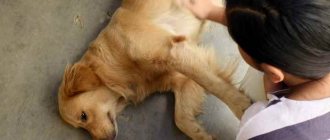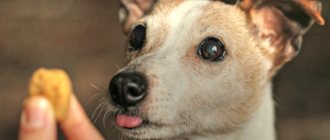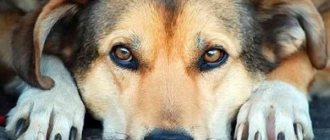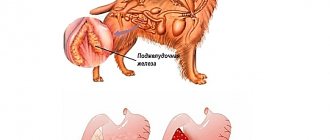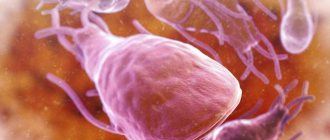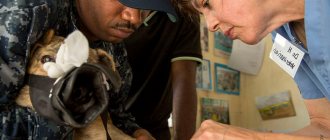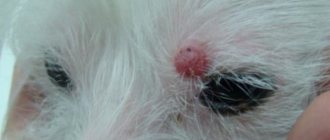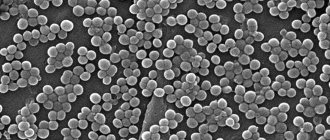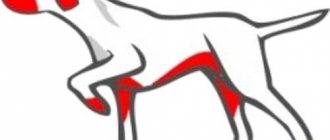Causes
A concussion in a dog can be caused by the following reasons:
- Head bruises. While playing, training, or running, the animal may hit its head on the corners of furniture, trees, or large stones.
- Road traffic accidents. Dogs walking on their own often get hit by cars.
- Blows to the head. Most often, such injuries occur due to heavy objects falling on the pet’s skull. This is the most dangerous type of damage. Such blows can lead not only to a concussion, but also to fractures of the head bones.
- Falling from a height. Such injuries often occur in small dogs when they fall out of their carrier.
- Gunshot wounds. This is a rare type of injury. Hunting dogs are usually susceptible to this type of injury.
Symptoms of a serious dog condition
If the owner witnesses that the puppy has fallen from a sofa, bed or other small height, then the pet’s health must be closely monitored. If the baby is not worried, his gait has not changed, lameness has not been noticed, appetite and thirst are preserved, and no pathologies from the urinary and digestive systems are detected, then there is no reason for alarm.
However, a fall from a height does not always end well for a dog. Veterinary experts strongly recommend that owners seek qualified help if the animal exhibits the following symptoms in the event of an unsuccessful landing:
- Coordination of movement is impaired. Your four-legged friend may experience lameness, unsteadiness, and a stiff gait. In severe cases, the animal cannot stand on its feet.
- A fall from a height in a dog is often accompanied by a violation of the act of urination and defecation. Spontaneous bowel movements and bladder emptying indicate serious spinal injury or neurological syndrome due to brain damage. The cause of the disorder of physiological functions can be bruises and blunt injuries of internal organs (kidneys, bladder).
- Neurological manifestations - convulsions, paralysis of the limbs, trembling of the eyeball, lack of reaction of the pupil to light, nystagmus - are signs of severe damage to the central nervous system of the animal, requiring immediate veterinary care.
- The dog whines and worries. The apathetic, lethargic state of the pet should alert the owner. Difficulty breathing, drooling, bloody foamy discharge from the mouth or nasal cavity, vomiting, refusal of food and water - a reason for an early visit to a specialized institution and a call to the home of a veterinary specialist.
The owner should be alerted not only to a deterioration in appetite, but also to difficulty in eating. Brain damage often manifests itself in the form of a contusion - the dog grabs food, but chokes and cannot swallow.
Degrees
There are several degrees of concussion in a dog:
- Easy. Accompanied by minor damage to tissues and blood vessels. Symptoms of a concussion are very mild and pass quickly. However, the animal should still be shown to a veterinarian. Sometimes even minor injuries can cause serious consequences in the future.
- Average. Neurological symptoms are moderately expressed. Without treatment, such injuries lead to complications from the central nervous system.
- Heavy. Accompanied by pronounced signs of traumatic brain injury. Often such damage causes the death of the pet.
Symptoms and treatment for a concussion in a dog depend on the extent of the injury. Next, we will look in detail at the signs of this disease.
Concussion in a dog and its consequences
Veterinarians say that if treatment is carried out in time under the supervision of a specialist, negative consequences will be avoided. Unfortunately, in serious situations, some irreversible things can also occur, for example, many animals lose their activity, and also occasionally experience panic attacks. Most often this occurs after concussions caused by an accident or due to something falling on the head.
In rare situations, your pet may become sensitive to temperatures or other adverse environmental conditions. Also, most likely, your pet's barking will change, and some animals generally change their behavior, for example, becoming extremely aggressive. With serious damage, vision may deteriorate or hearing may decrease. Consequences also include an increased risk of paralysis or epilepsy.
Currently reading:
- Pinched nerves and subtle symptoms in dogs
- Symptoms and actions for abdominal cramps in a dog
- Thyroid dysfunction in dogs (hypothyroidism)
- All the reasons why a dog starts to lose coordination
Symptoms
With a mild injury, the dog's behavior may not change at all. Such injuries are often asymptomatic. With severe head injuries, the following signs of a concussion in a dog occur:
- Lethargy and weakness. The animal becomes apathetic and inactive. Such symptoms are most often observed with mild bruises.
- Headache. If a pet constantly shakes its head after an injury or avoids unnecessary movements, then this indicates pain in the skull.
- Motor disorders. The animal's coordination of movements deteriorates. The pet staggers and falls when moved. This symptom of a concussion in a dog indicates a severe injury.
- Strange behavior. The dog becomes either too fearful or aggressive.
- Dyspeptic manifestations. The pet experiences nausea and vomiting that is not associated with food intake. The animal refuses to eat.
- Loss of consciousness. Fainting is especially dangerous if your dog is feeling nauseous. In such cases, it is necessary to immediately provide first aid to the animal, otherwise vomit may enter the respiratory tract.
- Sleep disorders. A sick dog sleeps unusually a lot. The animal avoids people, hides in a corner and lies down.
- Cardiac and respiratory disorders. After an injury, the pet is breathing heavily, and the heartbeat is too fast or rare.
- Dilated pupils and lack of reaction to light. This symptom indicates a very severe injury.
Extensive skull injuries in dogs are also accompanied by trembling of the eyes and involuntary urination and defecation. These are signs of severe neurological impairment. In such cases, it is necessary to call an emergency veterinarian at home. Otherwise, the pet may die.
It should be remembered that these symptoms do not always appear immediately after injury. There are cases when signs of brain damage appear several days after the injury.
First signs
A dog that has suffered a concussion may behave normally with a minor injury. With more severe injuries, the following signs and symptoms of a dog concussion occur:
- Lethargy, inert behavior, apathy. These are usually the first signs of a mild concussion.
- Headache, due to which the animal either tries to keep its head unnaturally straight and still, or shakes it vigorously.
- Impaired coordination of movements.
- Nausea, vomiting.
- Lack of appetite.
- The dog sleeps a lot, tries to hide from everyone, even from its owners.
- Loss of consciousness, unexpected fainting. Loss of consciousness is especially dangerous if the animal is constantly vomiting - it can choke on its own vomit.
- Inappropriate behavior up to and including attacks on its owner and strangers.
- In severe cases, breathing and heartbeat disturbances occur, and the pupils are dilated over the entire eye and do not respond.
Depending on the dog’s condition, appropriate assistance is provided.
Complications
Symptoms of a concussion in a dog should not be ignored. Untreated head injuries can lead to the following complications:
- stroke;
- paralysis of limbs;
- persistent movement coordination disorder;
- impairment of vision and hearing;
- intestinal motility disorders.
To avoid such severe consequences, you need to contact a veterinarian at the first sign of a concussion in your dog. The prognosis for this pathology directly depends on the timeliness of medical care.
How can you tell if your dog has a concussion?
The main signs of a concussion cannot be confused with anything else:
- lack of coordination of movements, unsteady gait, aimless walking in circles. A dog can show aggression for no reason, look around, be frightened by something invisible, growl;
- vomit;
- apathy, lethargy, lack of response to the owner’s call;
- lack of appetite and thirst;
- dilated pupils or their different shapes;
- trembling of the eyeballs, inability to focus on anything specific, fear of bright light;
- shaking of the limbs, vaguely similar to convulsions (but not convulsions), paralysis or paresis (failure of the front or rear limbs);
- involuntary urination;
- whining;
- headache, which is manifested by attempts to lean against something cold, while if you try to pat the dog on the head, it will not let you;
- change in color of the mucous membranes from too pale to deep red;
- the animal tries to grab the air or people nearby with its mouth, but does it somehow unconsciously (with this sign it is important to secure the mouth with a muzzle or simply bandage it with whatever is at hand - a bandage, a belt, a belt);
- loss of consciousness is possible for various periods of time, and in special cases, death without regaining consciousness. It is especially unfavorable if the animal does not lose consciousness immediately, but after some time;
- stopping breathing or heartbeat.
The peculiarity of the manifestation of concussion symptoms in dogs is the time intervals. Symptoms may appear immediately, or may take several hours or even days. That is why, if the owner witnesses any head injury - a fall or a blow - he should show the dog to a specialist immediately, without waiting for something to begin to appear outwardly.
First aid
If symptoms of a concussion appear in a dog, it is necessary to take the animal to a veterinarian as soon as possible. At the pre-medical stage, the pet must be given first aid:
- It is necessary to remove the collar and muzzle. These accessories may restrict your dog's breathing.
- You should not pet or soothe your pet. At this point, the dog’s behavior often becomes inappropriate, and the animal may bite the owner.
- The pet should be placed on a hard surface. The dog should lie on its side.
- The tongue must be removed from the mouth and kept in a protruding position. This will help prevent it from sinking.
- It is necessary to keep the animal's breathing and pulse under control.
- A cold compress is placed on the head to reduce pain.
- If the dog loses consciousness, artificial respiration should be given to the dog.
After first aid, you should immediately take the animal to a veterinary clinic. If your pet has not only a skull injury, but also other injuries (fractures, open wounds), then a doctor must be called to the house.
Injury Prevention
Considering the factors that lead to pets falling from heights, veterinary specialists and experienced dog breeders recommend that owners adhere to the following rules and recommendations:
- Walk your pet in specially designated areas and areas with a fence. Regularly check the area for safety, make sure that there are no open sewer wells or other technical structures on the walking area.
- Cultivate in your pet a tolerant attitude towards relatives and cats, and do not allow them to chase animals.
- Do not leave your four-legged friend in potentially dangerous places - on the balcony, open window, on high furniture.
- Miniature breeds should only be walked on a special harness that prevents the pet from slipping out of your hands.
We recommend reading about traumatic brain injury in dogs. From the article you will learn about the causes and types of TBI, symptoms, consequences for the animal, drug and surgical treatment.
And here is more information about paralysis in dogs.
Falling from a height is not a common injury for dogs. Nevertheless, the owner of a puppy, a dwarf pet, or an overly active representative of a large breed must be prepared to provide competent first aid. A fall from a height often has long-term consequences for a pet's body. Therefore, even in the absence of symptoms such as lameness, loss of appetite, impaired urination and defecation, the animal should be shown to a veterinarian.
Diagnostics
If a concussion is suspected, the veterinarian will order the following tests:
- MRI of the brain. This test helps determine the extent of traumatic injuries.
- X-ray. Using this method, bone damage can be determined.
- Electroencephalogram. The examination helps to identify the hidden consequences of injury.
It is necessary to show your pet to a veterinary ophthalmologist for a fundus examination, as well as a neurology specialist to assess reactions to stimuli.
Treatment methods
Mild to moderate concussions are treated on an outpatient basis. In case of severe injuries, the dog should be hospitalized.
In order to prevent cerebral edema, intravenous (drip) and intramuscular administration of the following drugs is prescribed:
- "Mannitol";
- "Calcium chloride";
- "Furosemide".
To avoid the severe consequences of injury, veterinarians administer nootropic drugs to animals:
- "Mexidol-vet";
- "Cerebrolysin";
- "Actovegin";
- "Piracetam."
Symptomatic treatment is also indicated:
- For headaches, analgesics are prescribed: “Baralgin”, “Travmatin”.
- For nausea, antiemetics are indicated: “Cerucal”, “Ondasetron”, “Serenia”.
- After severe injuries, medications are prescribed to maintain cardiac activity: “Cordiamin”, “Caffeine-vet”, “Sulphocamphocaine”.
- If the dog shows signs of agitation and aggression, then the administration of sedatives is indicated: Clonazepam, Vetpokoin, Seduxen, Spitomina.
- To generally strengthen the body and accelerate regeneration processes, vitamins and immunomodulators are prescribed: “Gamavit”, “Neurobeks”, “Vitam”.
It is important to remember that only a veterinarian can prescribe medications and determine their dosage. Self-treatment in this case is absolutely unacceptable.
The length of treatment for a concussion in a dog depends on the extent of the injury. The animal does not immediately recover from injury. For mild bruises, therapy and recovery period take several weeks. For severe injuries, rehabilitation can last many months.
Treatment
With a concussion, treatment cannot be unambiguous, since it completely depends on the degree of damage. In most situations, therapy is aimed at the use of vascular drugs, as well as agents necessary to accelerate regeneration.
Drugs are also used to reduce intracranial pressure, as well as those that improve blood circulation and eliminate pain. In rare difficult situations, veterinarians resort to the use of sedatives, and sometimes sleeping pills.
Help from the owner is also important; he must provide the pet with complete peace, relieving any emotional or physical stress. Feed the dog in small portions; in such situations, dietary food is required. The best option would be to leave the dog in the clinic for several days so that doctors can monitor its condition.
Veterinarians say that if treatment is carried out in time under the supervision of a specialist, negative consequences will be avoided. Unfortunately, in serious situations, some irreversible things can also occur, for example, many animals lose their activity, and also occasionally experience panic attacks. Most often this occurs after concussions caused by an accident or due to something falling on the head.
In rare situations, your pet may become sensitive to temperatures or other adverse environmental conditions. Also, most likely, your pet's barking will change, and some animals generally change their behavior, for example, becoming extremely aggressive. With serious damage, vision may deteriorate or hearing may decrease. Consequences also include an increased risk of paralysis or epilepsy.
About the author: Anna Mikhailovna Tarasova
My specialty is surgery and veterinary medicine for dogs and exotic pets, I also do internal medicine and radiology. Read more about me in the “About Us” section.
The outcome of recovery depends on the severity of the concussion. And also on how quickly the owners seek veterinary help.
In most cases, the pet quickly regains activity. But there are also irreversible consequences, for example, panic attacks. This may be the result of severe brain damage.
Your pet's voice may change. In rare cases, behavioral disorders are observed. This is either extreme passivity or aggressiveness of the dog.
To prevent a concussion and other injuries, it is not advisable to let your pet go for a walk alone. A little attention from the owner to his animal will preserve its life and health.
If after an injury the dog loses consciousness, it is urgent to take the following action plan:
- Determine whether there are signs of shock.
- lay the pet on a hard surface, on its side.
- Immediately remove the collar or other objects that prevent the animal from breathing.
- Stick out your tongue, as there is a high probability that it will get stuck in the throat and the dog will suffocate.
- Apply an ice compress to the animal's head.
- Check your pulse. You can feel it by placing your fingers on the inner thigh; the femoral artery is located there. The number of blows in dogs ranges from 70-120 per minute. Young dogs and small breeds have a faster heart rate.
You should also check your breathing. This is very easy to do; you need to count the number of inhalations and exhalations per minute. Normally, the respiratory rate ranges from 10-30 per minute. Depends on the time of year, age, gender and breed of dog. If your pet is breathing very weakly or has stopped showing any signs of life, you should immediately perform artificial respiration. To do this you need:
- Place the dog on its right side.
- Clean your mouth with a tissue or handkerchief.
- Move your tongue to the side, press the dog’s muzzle tightly to your lips, so that the dog’s nose and mouth are in your mouth.
- Carefully blow in air, twitching your tongue every five seconds.
As soon as the dog regains consciousness, immediately take it to the veterinary clinic. When transporting, you must be especially careful, as shaking can greatly worsen the animal’s condition. It is advisable to carry it on special stretchers or wooden shields. It is not recommended to feed and water your dog. Self-medication is strictly prohibited!
If the presence of a concussion is confirmed, the doctor should prescribe medications to reduce intracranial pressure, relieve pain, relieve spasms and improve blood circulation. For a speedy recovery, vascular medications are prescribed.
If the concussion is moderate or severe, then symptomatic therapy is also prescribed, which includes sleeping pills and sedatives. During the recovery period, the dog needs complete rest.
Necessary:
- Minimize emotional and physical stress.
- Follow a diet that includes minimal salt, fat and spices in your dog's food, as well as feeding small portions.
- During recovery, you still need to visit a neurologist for some time, who will monitor the pet’s condition.
To reduce the risk of concussion in dogs:
- Minimize your pet's heavy physical activity.
- Balanced diet.
- Walk your dog only in approved places.
- Remove as much as possible any traumatic objects that may surround your pet.
- Once every six months or a year, for preventive maintenance, take him for examination to a veterinarian.
- Be extremely careful with animals on the roads, do not let them go without a leash.
A concussion is very dangerous for the life and health of a dog, so if you notice even minor symptoms of a concussion, it is better to immediately contact a veterinarian, otherwise everything can end in death. Monitor your pet's behavior and condition!
Rules for caring for animals
If a dog has symptoms of a concussion, it is necessary to ensure complete rest for the animal. The pet should be placed in a quiet, darkened room. It should be remembered that any sharp sounds intensify headaches and cause anxiety.
It is necessary to protect the animal from playing with small children. You should also temporarily avoid taking your pet out for long walks. Dog training should be delayed until the dog's concussion symptoms have completely resolved.
It is also important to protect the animal from hypothermia. The room in which the pet lies must be warm. You should also pay attention to feeding. During the period of illness, the dog should be given light food so as not to provoke vomiting. It is useful to switch your pet to special dietary food.
Therapy for concussions in dogs
The appointment can only be made by a veterinarian. You cannot self-medicate or let the disease take its course. This can not only worsen the pet’s condition, but also lead to its death.
It is important to understand that severe concussions in dogs require treatment in a clinic. This means hospitalization will be required for several days.
Under no circumstances should you give your dog “human” medications. This can not only worsen the pet’s condition, but also complicate the diagnosis.
For treatment, the doctor may prescribe medications that reduce cranial pressure. The pet will also take medications to improve blood circulation.
If the dog suffers from a headache, then analgesics are prescribed. Occasionally, if the animal is very restless, sedatives and sleeping pills are recommended.
The owner of the house needs to provide complete peace and quiet for the pet. If there are children, then it is important to explain to them that they cannot touch the dog.
The animal must be fed in small portions. The food needs to be prepared as dietary, semi-liquid.
With a mild concussion, the dog will need 5 to 7-8 days to recover. For severe cases, from several weeks to 2-3 months. The rehabilitation of the pet will depend on the severity. It can last about six months.
Prevention
How to prevent concussions in animals? To protect your dog from injury, the following recommendations must be followed:
- Do not let your pet go for independent walks.
- During walks, let your dog off the leash only in safe places.
- Outdoor games and training sessions can only be carried out in open spaces. It is necessary to ensure that there are no large stones or trees nearby.
- You should remove all dangerous objects in the apartment that could fall on the dog’s head.
Following these simple measures will help keep your pet healthy.

